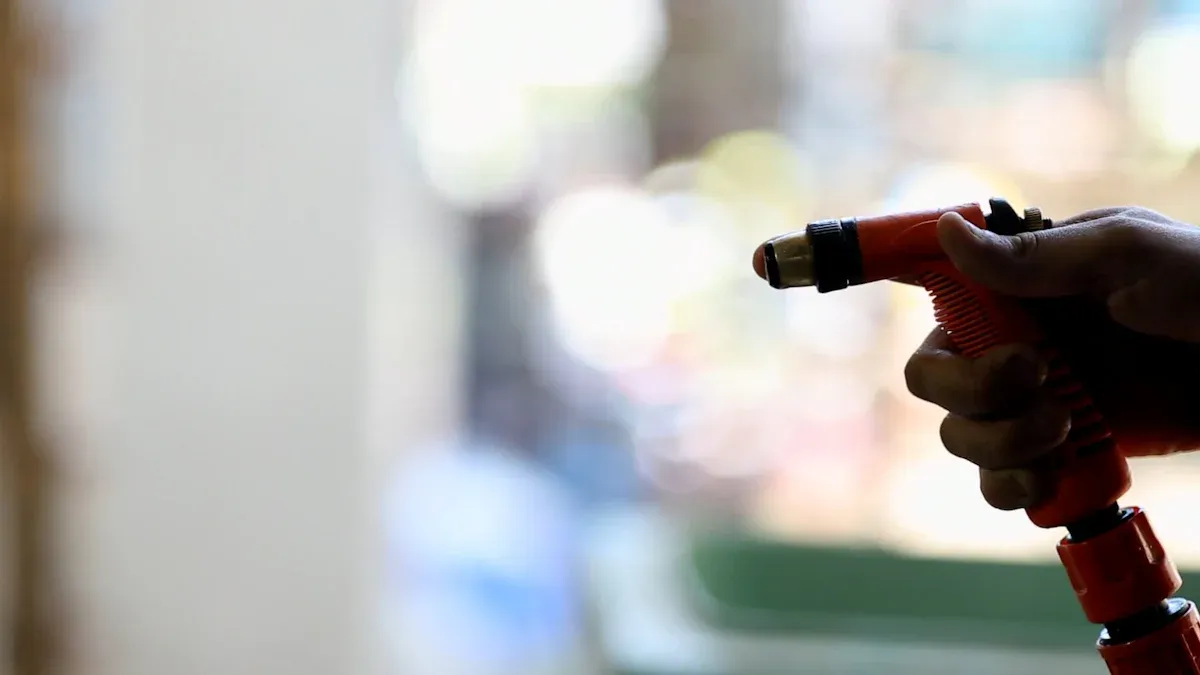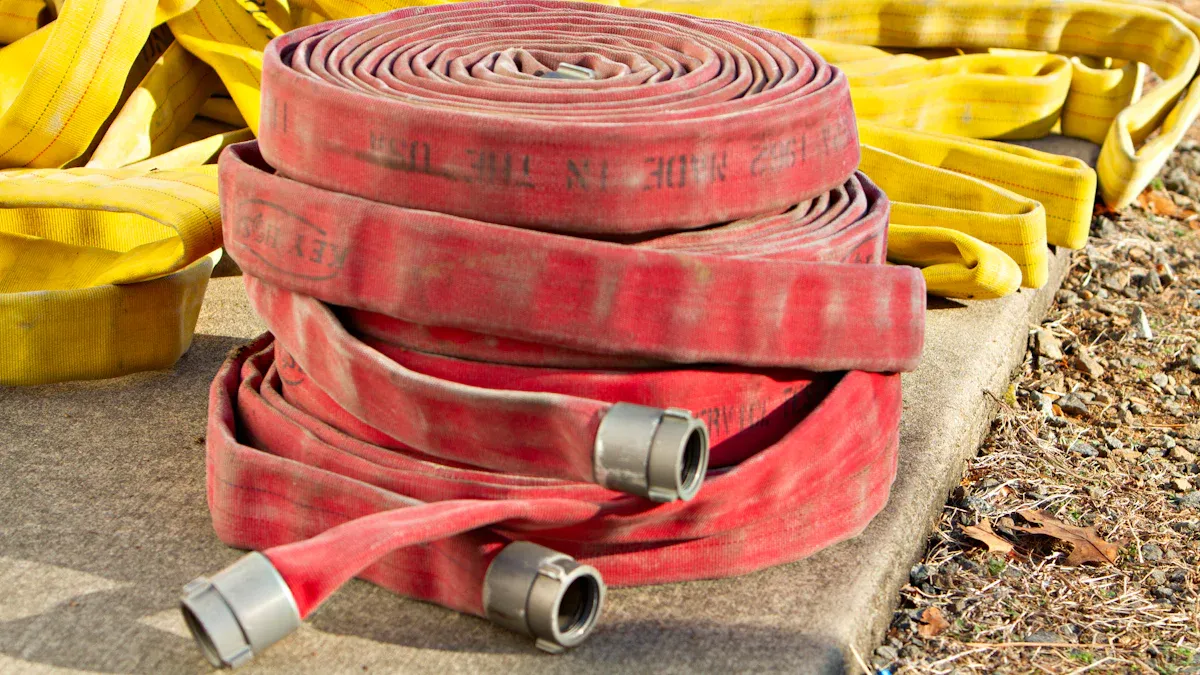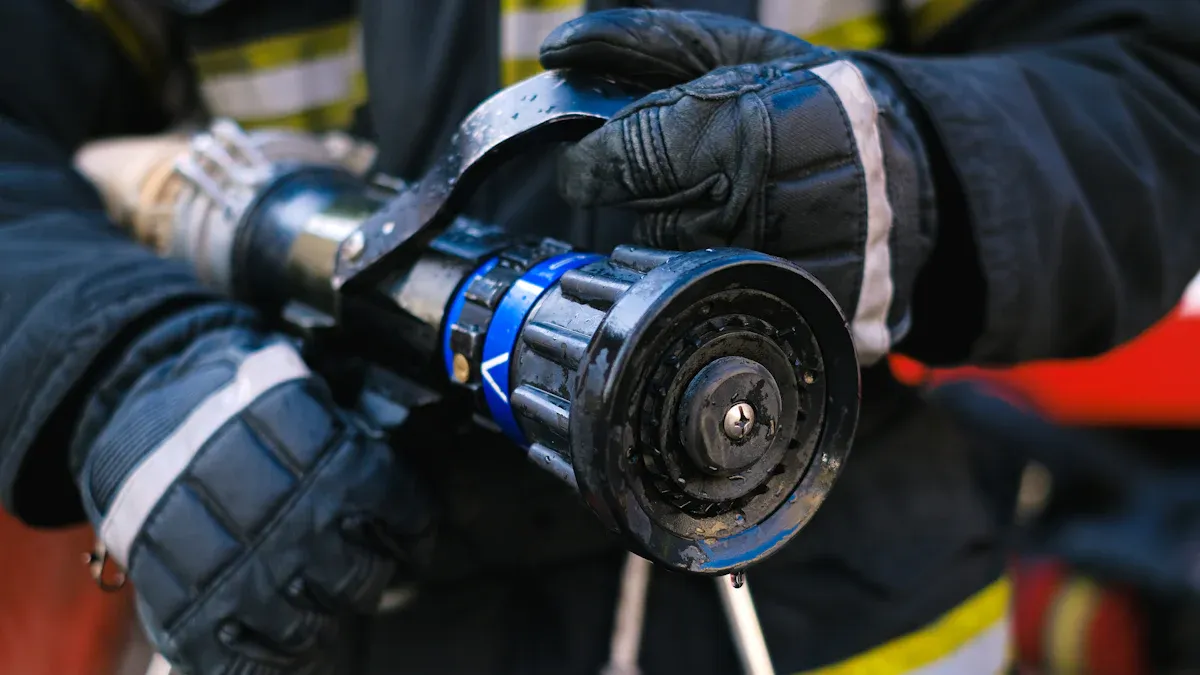
Brass, stainless steel, aluminum, plastic, composite, and gunmetal serve as the most common branchpipe nozzle materials. Stainless steel provides the highest durability, especially in abrasive flows with high turbulence. Plastic and composite options offer lower cost but less strength. Brass and gunmetal balance corrosion resistance and performance in many environments. Firefighters often select a multi-functional nozzle, foam eductor, or foam nozzle for specific hazards. High pressure nozzle designs with optimized geometry can reduce erosion and extend service life.
Key Takeaways
- Choose nozzle materials based on your environment and needs; stainless steel suits harsh, corrosive areas, while plastic fits training or low-risk uses.
- Balance durability, weight, and cost: brass and gunmetal offer strength and corrosion resistance, aluminum and plastic reduce weight and cost.
- Regularly inspect nozzles for damage and replace them as needed to ensure safety and long service life.
Common Branchpipe Nozzle Materials

Brass Branchpipe Nozzle
Brass nozzles offer a classic choice for many fire services. They resist corrosion and provide good strength. Many users prefer brass for its balance between durability and cost.
Note: Brass nozzles often last longer in moderate environments.
Stainless Steel Branchpipe Nozzle
Stainless steel stands out for its high resistance to rust and chemicals. This material handles high-pressure water flow and abrasive conditions well. Stainless steel nozzles suit harsh industrial or marine settings.
Aluminum Branchpipe Nozzle
Aluminum nozzles weigh less than other options. Firefighters often select aluminum when they need to reduce equipment weight. Aluminum resists corrosion but may dent or scratch more easily than steel.
Plastic and Composite Branchpipe Nozzle
Plastic and composite nozzles provide a lightweight and affordable solution. These materials resist many chemicals and do not rust. However, they may not withstand high temperatures or impacts as well as metal options.
Gunmetal Branchpipe Nozzle
Gunmetal nozzles combine copper, tin, and zinc. This alloy resists corrosion and offers good mechanical strength. Many users choose gunmetal for its reliability in both fresh and saltwater environments.
Brass Branchpipe Nozzle Pros and Cons
Pros
- Brass nozzles resist corrosion from water and many chemicals.
- They offer good mechanical strength, which helps prevent damage during use.
- Many fire departments trust brass for its long service life in moderate environments.
- Brass provides a smooth water flow, which improves firefighting efficiency.
- Maintenance is simple because brass does not rust or pit easily.
- Yuyao World Fire Fighting Equipment Factory manufactures brass nozzles with strict quality control, ensuring consistent performance.
Tip: Brass nozzles often keep their appearance and function even after years of regular use.
Cons
- Brass weighs more than aluminum or plastic, which can make hoses harder to handle for long periods.
- The cost of brass is higher than some other materials, such as plastic or aluminum.
- Brass can tarnish over time, which may require polishing to maintain its look.
- In very harsh or salty environments, brass may not last as long as stainless steel.
Typical Applications
- Firefighters use brass branchpipe nozzles in municipal fire services and building protection systems.
- Many industrial sites choose brass for general-purpose firefighting.
- Brass nozzles work well in schools, hospitals, and commercial buildings.
- Yuyao World Fire Fighting Equipment Factory supplies brass nozzles for both indoor and outdoor fire safety systems.
Note: Brass branchpipe nozzles provide a reliable choice for most standard firefighting needs.
Stainless Steel Branchpipe Nozzle Pros and Cons
Pros
- Stainless steel nozzles offer excellent resistance to rust and corrosion.
- They handle high-pressure water flow without deforming or cracking.
- These nozzles perform well in environments with chemicals or saltwater.
- Stainless steel provides a long service life, even with frequent use.
- Many users find that cleaning and maintaining stainless steel is easy.
- Yuyao World Fire Fighting Equipment Factory produces stainless steel branchpipe nozzles that meet strict industry standards.
Note: Stainless steel nozzles keep their strength and appearance in harsh conditions.
Cons
- Stainless steel weighs more than aluminum or plastic, which can make hoses heavier.
- The cost of stainless steel is higher than most other materials.
- If dropped, stainless steel nozzles may dent or scratch, though less than softer metals.
- Some users may find stainless steel nozzles harder to repair if damaged.
Typical Applications
- Firefighters use stainless steel branchpipe nozzles in chemical plants and marine environments.
- Many industrial sites choose stainless steel for areas with high corrosion risk.
- Stainless steel nozzles work well in offshore oil rigs and coastal facilities.
- Yuyao World Fire Fighting Equipment Factory supplies stainless steel nozzles for demanding firefighting operations.
Tip: Stainless steel branchpipe nozzles provide the best choice for harsh or corrosive environments.
Aluminum Branchpipe Nozzle Pros and Cons
Pros
- Aluminum nozzles weigh much less than brass or stainless steel options. Firefighters can handle hoses with less fatigue during long operations.
- The material resists corrosion, which helps extend the service life in damp or humid environments.
- Aluminum branchpipe nozzles cost less than many metal alternatives. This makes them a popular choice for departments with limited budgets.
- The smooth surface of aluminum allows for easy cleaning and maintenance.
- Yuyao World Fire Fighting Equipment Factory produces aluminum nozzles with precise machining, ensuring consistent water flow and reliable performance.
Tip: Aluminum nozzles work well for rapid deployment and mobile firefighting units due to their lightweight design.
Cons
- Aluminum dents and scratches more easily than stainless steel or gunmetal. Heavy impacts may cause deformation.
- The material does not handle extremely high temperatures as well as brass or stainless steel.
- Over time, aluminum may develop a dull finish, especially with frequent outdoor use.
- Some users report that aluminum branchpipe nozzles may not last as long in harsh industrial settings.
Typical Applications
- Firefighters often select aluminum branchpipe nozzles for wildland and forest firefighting, where weight reduction is critical.
- Many emergency response teams use aluminum nozzles for quick-response vehicles and portable fire pumps.
- Schools, warehouses, and commercial buildings sometimes choose aluminum for their fire safety systems.
- Yuyao World Fire Fighting Equipment Factory supplies aluminum nozzles to customers who need lightweight and cost-effective solutions.
Note: Aluminum branchpipe nozzles provide a practical option for teams that value mobility and ease of use.
Plastic and Composite Branchpipe Nozzle Pros and Cons
Pros
- Plastic and composite nozzles weigh less than metal options. Firefighters can carry and operate them with less effort.
- These materials resist corrosion from water and many chemicals. They do not rust or pit, even after long-term exposure.
- Plastic and composite branchpipe nozzles cost less than brass or stainless steel. Many fire departments choose them for budget-friendly solutions.
- The smooth surface of plastic makes cleaning simple. Composite materials often include fiberglass or reinforced polymers, which add strength.
- Yuyao World Fire Fighting Equipment Factory manufactures plastic and composite nozzles with strict quality checks. Customers receive reliable products that meet safety standards.
Tip: Plastic and composite nozzles work well for training exercises and temporary installations.
Cons
- Plastic and composite nozzles do not handle high temperatures as well as metal types. Exposure to fire or hot surfaces may cause warping or melting.
- These materials break or crack more easily if dropped or struck. They offer less impact resistance than brass or stainless steel.
- Some users report that plastic nozzles may not last as long in harsh industrial environments.
- Composite nozzles sometimes cost more than basic plastic models, depending on the reinforcement used.
Typical Applications
- Firefighters use plastic and composite branchpipe nozzles for indoor fire safety systems in schools, offices, and hospitals.
- Many training centers select these nozzles for practice drills because of their low cost and light weight.
- Yuyao World Fire Fighting Equipment Factory supplies plastic and composite nozzles for temporary setups, mobile units, and areas with low fire risk.
Note: Plastic and composite branchpipe nozzles provide a practical choice for non-critical or short-term firefighting needs.
Gunmetal Branchpipe Nozzle Pros and Cons
Pros
- Gunmetal nozzles resist corrosion from both fresh and saltwater. This property makes them ideal for marine and coastal environments.
- The alloy provides strong mechanical strength. Users can rely on these nozzles to withstand rough handling and high water pressure.
- Gunmetal maintains its shape and performance even after years of use. Many fire departments trust this material for its proven durability.
- The surface of gunmetal does not rust or pit easily. Maintenance remains simple and cleaning takes little time.
- Yuyao World Fire Fighting Equipment Factory produces gunmetal branchpipe nozzles that meet strict quality standards. Customers receive reliable products for demanding conditions.
Note: Gunmetal nozzles often last longer than aluminum or plastic options in harsh environments.
Cons
- Gunmetal weighs more than aluminum or plastic. Firefighters may find hoses heavier during long operations.
- The cost of gunmetal nozzles is higher than basic plastic or aluminum models.
- If dropped on a hard surface, gunmetal can dent or deform. Careful handling helps prevent damage.
- Some users report that gunmetal nozzles may tarnish over time, which affects appearance but not function.
Typical Applications
- Firefighters use gunmetal branchpipe nozzles in ports, ships, and coastal facilities.
- Many industrial sites select gunmetal for areas with high corrosion risk.
- Yuyao World Fire Fighting Equipment Factory supplies gunmetal nozzles for municipal fire services and marine firefighting systems.
Tip: Gunmetal branchpipe nozzles provide a dependable choice for environments where corrosion resistance is critical.
Branchpipe Nozzle Materials Comparison Table

Selecting the right Branchpipe Nozzle material depends on several factors. Each material offers unique strengths and weaknesses. The table below compares the most common options. It helps users quickly see which material fits their needs best.
| Material | Durability | Corrosion Resistance | Weight | Cost | Typical Use Cases |
|---|---|---|---|---|---|
| Brass | High | Good | Medium | Medium | Municipal, industrial, buildings |
| Stainless Steel | Very High | Excellent | Heavy | High | Marine, chemical, offshore |
| Aluminum | Medium | Good | Light | Low | Wildland, mobile, schools |
| Plastic/Composite | Low-Medium | Good | Very Light | Very Low | Training, indoor, temporary |
| Gunmetal | High | Excellent | Heavy | High | Marine, ports, coastal |
Tip: Users should match the Branchpipe Nozzle material to the environment and expected use. For example, stainless steel works best in harsh or salty areas, while plastic suits training or low-risk settings.
Key points to consider:
- Durability affects how long the nozzle lasts.
- Corrosion resistance matters in wet or chemical-rich places.
- Weight impacts how easy it is to handle the hose.
- Cost can influence large-scale purchases.
This comparison table gives a clear overview. It helps users make informed decisions based on their specific requirements.
How to Choose the Right Branchpipe Nozzle Material
Application Needs
Selecting the right Branchpipe Nozzle starts with understanding the job requirements. Firefighters often need nozzles that match the type of fire and the water pressure available. Industrial sites may require nozzles that handle chemicals or high temperatures. Users should list the main tasks for the nozzle. For example, wildland firefighting teams often choose lightweight options for fast movement. Municipal fire departments may prefer durable nozzles for daily use.
Tip: Always match the nozzle type to the most common emergency faced.
Environmental Factors
The environment plays a big role in material choice. Areas near the ocean need nozzles that resist saltwater corrosion. Chemical plants require materials that do not react with harsh substances. Outdoor use demands weather-resistant options. Users should check if the nozzle will face extreme heat, cold, or moisture. Stainless steel and gunmetal work well in harsh or wet environments. Plastic and aluminum suit indoor or mild conditions.
- Consider these factors:
- Exposure to chemicals
- Saltwater or humidity
- Temperature extremes
Budget Considerations
Cost affects every purchase decision. Departments with tight budgets may select plastic or aluminum nozzles for affordability. Long-term savings come from choosing durable materials that last longer. Brass and gunmetal cost more upfront but offer better service life. Users should balance initial price with expected maintenance and replacement costs.
Note: Investing in quality materials can reduce future expenses.
Selecting the right Branchpipe Nozzle depends on several factors.
- Brass and gunmetal offer strength and corrosion resistance.
- Stainless steel provides top durability.
- Aluminum and plastic reduce weight and cost.
Always match material to environment and budget. Careful choices ensure safety and long-term value.
FAQ
What is the most durable branchpipe nozzle material?
Stainless steel offers the highest durability. It resists corrosion and damage in harsh environments. Many professionals choose it for long-term use.
Are plastic branchpipe nozzles safe for firefighting?
Plastic nozzles work well for training and low-risk areas. They do not handle high heat or impact as well as metal options.
How often should a branchpipe nozzle be replaced?
- Inspect nozzles regularly.
- Replace them if you see cracks, corrosion, or leaks.
- Most metal nozzles last several years with proper care.
Post time: Jul-02-2025

